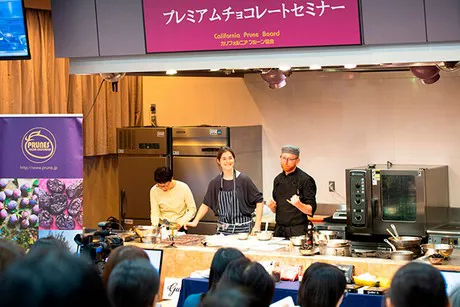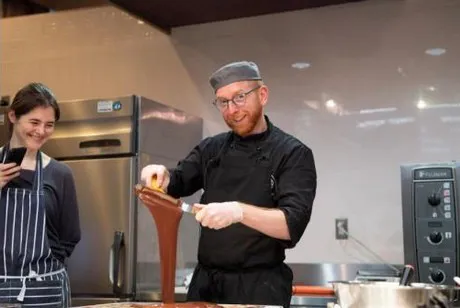UK chocolatier Paul.a.young, recently visited Japan as part of his ambassador role with the California Prune Board.
The California Prune Premium Chocolate Seminar was a tutorial for participants to learn recipes directly from Paul.a.young. Held on November 7, 2018 at the Tokyo Culinary and Confectionery Arts Academy in Shinjuku, Tokyo the event included a demonstration from Paul.a.young himself who was visiting Japan for the very first time. Supporting the effort, as a special assistant, was Stacey Ward head of “Mornington Crescent”, a British confectionery cooking school renowned for having waiting lines of students outside.
Commenting on Paul.a.young’s visit to Japan, European Marketing Director of the California Prune Board, Esther Ritson-Elliott said, “We are delighted that Paul was able to visit Japan in his role as ambassador for the California Prune Board, to present at the California Prune Premium Chocolate Seminar and share his expertise with the Japanese market and share his passion for California prunes.”

Chocolatier Paul.a.Young speaks at the seminar
Choosing the finest ingredients for simple preparations
“The quality of ingredients is one area in which I absolutely refuse to compromise," Said Young. "Plus, because the ingredients used are so marvellous, my goal is to avoid making the creations overly complex, while at the same time coaxing out their true worth with fastidious handmade care. That, in a word, is the starting point for my chocolate creation.”
One of the ingredients Paul.a.Young uses in his chocolates are California prune. In Great Britain, prunes enjoy the image as a food excellent for digestion and intestinal function. During his childhood years, Paul.a.young recalls that he often ate soft-boiled prunes when suffering from colds.
“As a chocolatier, however, I determined to rise to the challenge of using more innovative methods to create chocolate with prunes. To my good fortune, California prunes come in numerous variations. In addition to their whole state, they are also available in puree, powder and concentrated fruit juice forms. That gives them appeal for being easy to incorporate into all sorts of different recipes!”
Presented in the seminar were three prune formulations – puree, powder and concentrated fruit juice. Through combinations with chocolate from Guittard Chocolate Company, he showcased two different chocolate creations.
California Prunes
The term “prune” refers to dried plums. “California prunes” are cultivated in the fertile earth and warm climate of the state of California. Their roots are said to lie in varieties native to Southern France. According to the company, this helps elevate them to the status of an essential component in the chocolates of Paul.a.young whose creations that contain no artificial ingredients.

California prunes and peanut butter chocolate bars
Paul.a.young’s first creation consisted of chocolate bars made from California prunes and peanut butter. He said that both of these ingredients are moderate in sugars, while being high in dietary fiber and nutritional value.
According to Paul.a.young: “Prunes and dark chocolate provide a superbly compatible combination. While for this recipe we are using puree, it is also just fine to chop up whole prunes in hot water using a food processor to yield the same type of texture.”
When blending the prune puree and peanut butter, adding a dash of salt reportedly enhances the aroma and sweetness of the filling. After that, it is mixed into dark chocolate then slowly melted in advance, through the “bain-marie” method of being placed in hot water and then cooled on a baking tray and cut up into stick-shaped bars.
Yet another distinguishing trait of this chocolate, says Paul, is the “Fact that it is a sweet that keeps particularly well over time. Even after a full year, there will be no decline in either the quality or the tasty flavor. Thanks to the high-water retention of prune puree, the moistness of the chocolate is maintained over the long term, effectively functioning as a natural preservative. Before I started using prunes, the expiration date of chocolates was always a cause of concern. So, this was definitely a pleasant surprise.”
California prunes and dark beer truffles
These round-shaped truffle chocolates originally debuted at one of Paul.a.young’s London chocolate shops in 2013. Packed into these shells are ganache formed from prune puree combined with hearty portions of porter, stout and other varieties of dark beer, heated and mixed with milk chocolate.
Paul.a.young explains, “Adding the prune puree generates the aromas of caramel, bitter toffee and other sweets, and even richer flavor. With the natural sweetness augmenting the sugar content, it becomes possible to vastly reduce the volume of sugar used.”

Chef Paul further elaborated on the vast potential of prunes, noting how partially substituting prune puree for sugar “makes it possible to lengthen the freshness deadline by one to three months.”
California prune potential as replacements for sugar, fats and other ingredients
The demonstrations were followed by a Q&A session with participants, during which queries focused on the affinity between California prunes and chocolate.
One of the comments was its use as a sugar substitute. Explains Chef Paul: “Prunes, and especially those in concentrated fruit-juice form, serve to stabilize quality. Even when put into a ganache, the viscosity and smoothness are sustained.” What’s more, thanks to high water retention properties, it becomes possible to hold moisture on the inner side of the shell. That eliminates worries about surface cracking and breakdowns in the sweets themselves."
“I also give high marks to the use of prunes in place of butter, oils and other fats,” he added. "Prunes are a 100-percent natural ingredient, the freshness and moist feel they bring to the finished products are by no means inferior to butter. This opens the way to delicious sweets for those who wish to curb sugar, oil and fat intake for health reasons. For a chocolatier, there could be no greater joy.”
For more information:
Abby Davies
Ph: +44 (0)1858 462656
pr@cpbeurope.eu.com
